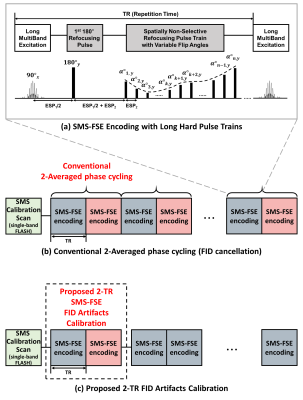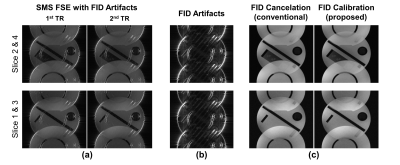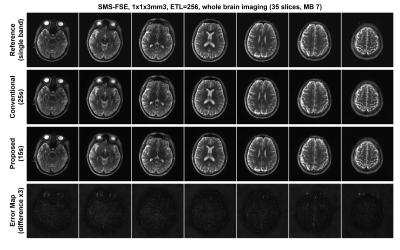2667
Accelerated SMS-FSE with Long Hard Pulse Trains and Spatially Invariant FID Suppression1Department of Biomedical Engineering, Sungkyunkwan University, Suwon, Republic of Korea
Synopsis
Simultaneous multi-slice (SMS) FSE in [1] was shown to be efficient for slice acceleration without much loss of signals. Despite its gains, conventional SMS-FSE, which employs high-flip-angle, spatially selective multi-band RF pulses in both excitation and refocusing, remains challenging particularly on high magnetic field due to high energy deposition and limited echo train length (ETL), eventually leading to low imaging efficiency. To alleviate this problem, we recently introduced a variable-flip-angle (VFA) SMS-FSE imaging with long hard pulse trains in which spatially selective multi-band RF pulses are used only for excitation while all refocusing RF pulses are short and non-selective2. Nevertheless, this approach still remains sub-optimal due to the 180° phase cycling in the refocusing pulse trains over two averages for FID suppression. Thus, the purpose of this work is to develop a novel, accelerated SMS-FSE with long hard pulse trains and spatially invariant FID suppression in which sharable FID artifacts are directly constructed using only 2-TR calibration scan instead of 2-average phase cycling scan and then subtracted. It is demonstrated that the proposed SMS-FSE with an SMS factor of 7 makes it possible to complete whole brain imaging only in 15 sec without apparent artifacts and noise.
Introduction
Simultaneous multi-slice (SMS) FSE in [1] was shown to be efficient for slice acceleration without much loss of signals. Despite its gains, conventional SMS-FSE, which employs high-flip-angle, spatially selective multi-band RF pulses in both excitation and refocusing, remains challenging particularly on high magnetic field due to high energy deposition and limited echo train length (ETL), eventually leading to low imaging efficiency. To alleviate this problem, we recently introduced a variable-flip-angle (VFA) SMS-FSE imaging with long hard pulse trains in which spatially selective multi-band RF pulses are used only for excitation while all refocusing RF pulses are short and non-selective2. Nevertheless, this approach still remains sub-optimal due to the 180° phase cycling in the refocusing pulse trains over two averages for FID suppression. Thus, the purpose of this work is to develop a novel, accelerated SMS-FSE with long hard pulse trains and spatially invariant FID suppression in which sharable FID artifacts are directly constructed using only 2-TR calibration scan instead of 2-average phase cycling scan and then subtracted. It is demonstrated that the proposed SMS-FSE with an SMS factor of 7 makes it possible to complete whole brain imaging only in 15 sec without apparent artifacts and noise.Materials and Method
SMS Encoding and FID Calibration: A schematic and timing diagram of the proposed SMS-FSE pulse sequence with respect to image encoding is shown in Fig.1(a). It consists of a relatively long multi-band excitation RF pulse followed by non-selective, VFA refocusing pulse trains. To maintain the shortest possible ESP in the refocusing pulse train while accommodating long multi-band excitation pulse, the first ESP is correspondingly much longer than the regular ESP. To avoid potential loss of signals due to the non-CPMG condition, the flip angle of the first refocusing pulse is set to 180° to position spin population fully on spin echo pathways. To better condition aliasing separation in the slice direction, CAIPI gradient blips in the corresponding direction are set and rewound on either side of the readout to induce additional spatial modulations. The proposed SMS-FSE with hard pulse trains typically suffers from FID artifacts mainly arising outside the simultaneously excited slices of interest. Fig.1(b) represents our previous approach, 180° phase cycling over two averages to cancel FID artifacts, doubling a regular imaging time. Instead, since the FID artifacts arising outside the slices of interest are sharable and nearly spatially invariant, we propose only a 2-TR phase-cycled FID calibration scan (Fig.1(c)) prior to SMS-FSE encoding to directly construct FID induced artifacts using subtraction. Thus, imaging time in Fig.1(c) is nearly halved than that in Fig.1(b).
FID Elimination and SMS Reconstruction: The directly estimated FID signals are subtracted from SMS-encoded data in k-space. Then, to avoid undesirable phase accumulations in off-center slices due to the CAIPI gradient blips, phase correction is to be applied. Slice unaliasing is performed using the recently introduced SMS-HSL approach3 in which a slice-specific null space, which is constructed using the Hankel subspace learning, is employed to suppress slices of no interest while passing only a slice of interest.
Data Acquisition: To validate the spatial invariance of FID artifacts in the proposed SMS-FSE with long hard pulse trains and investigate the effectiveness of the proposed method on FID suppression as compared to conventional 2-averaged phase cycling, two sets of data were acquired in a phantom using the proposed SMS-FSE with long hard pulse trains (# of slices = 4, SMS factor = 2, CAIPI factor = 2) on a 3T whole-body MR scanner (Siemens, Trio). Then, a set of T2-weighted whole brain data was acquired using the proposed SMS-FSE (SMS factor=7, CAIPI factor=5, TR/TE/TEeff=2500/417ms/112ms, resolution=1x1x3mm3; ETL=256; ESP=3.26ms; bandwidth=781Hz/Pix).
Results
Fig.2 shows the effectiveness of the proposed method on FID artifact suppression. With varying slices of interest in SMS-FSE, FID artifacts remain nearly spatially invariant (Fig,2(b)) and are then completely eliminated after subtraction. Fig.2(c) represents FID-suppressed phantom images (SMS factor=2) using conventional 2-averaged phase cycling (left) and the proposed 2-TR calibration (right). Fig.3 represents FID-suppressed brain images (SMS factor=7) using conventional 2-averaged phase cycling (the second row, 25s) and the proposed 2-TR calibration (the third row, 15s). In all cases, as compared to conven-tional phase cycling, the proposed SMS-FSE with spatially invariant FID sup-pression decreases imaging time nearly twice and yields comparable quality of images.
Conclusion
We successfully demonstrated the feasibility of the proposed, accelerated SMS-FSE with long hard pulse trains and spatially invariant FID suppression, enhancing imaging efficiency nearly twice without apparent artifacts.Acknowledgements
This research was supported by the National Research Foundation of Korea (NRF) funded by the Ministry of Science (2016M3C7A1913844, NRF-2017R1A2B4012581).References
1. Borjan A.G, Berkin B, Cornelius E, Himanshu B, Ellen G, Lawrence L.W, Kawin S, et al. RARE/Turbo Spin Echo Imaging with Simultaneous Multislice Wave-CAIPI. Magn Reson Med. 2015;73:929-938
2. Eun Ji L, Jaeseok P, et al. Slice-Accelerated Single-Shot Variable-Flip-Angle Fast Spin Echo with Very Long Echo Trains. In Proc. ISMRM 2017 (1483)
3. Suhyung P, Jaeseok P, et al. SMS-HSL: Simultaneous multislice aliasing separation exploiting hankel subspace learning. Magn Reson Med. 2017; 78;1392–1404
Figures



Figure 3. FID-suppressed brain images (SMS factor=7) using conventional 2-averaged phase cycling (the second row, 25s) and the proposed 2-TR calibration (the third row, 15s). Note that the proposed SMS-FSE with spatially invariant FID suppression decreases imaging time nearly twice and yields comparable quality of images as compared to conventional phase cycling.